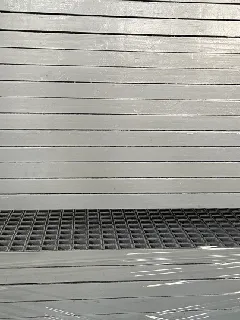loading...
- No. 9, Xingyuan South Street, Dongwaihuan Road, Zaoqiang County, Hengshui, Hebei, China
- admin@zjcomposites.com
- +86 15097380338
- Welcome to visit our website!
anti slip decking
Understanding Anti-Slip Decking A Safe and Stylish Outdoor Solution
When it comes to outdoor spaces, homeowners often seek a combination of aesthetics and safety. One of the most effective solutions to achieve this balance is anti-slip decking. This innovative outdoor flooring provides a secure surface while enhancing the beauty of patios, balconies, and pool areas. In this article, we will explore the importance of anti-slip decking, its various types, installation considerations, and maintenance tips.
Why Choose Anti-Slip Decking?
The primary advantage of anti-slip decking is safety. Wet or oily surfaces can become dangerously slippery, leading to accidents and injuries. Anti-slip decking is designed with textured surfaces or special coatings that enhance grip, significantly reducing the risk of slips and falls. This feature is particularly vital in areas exposed to water, such as swimming pools, spas, or outdoor kitchens.
Aside from safety, anti-slip decking comes in various styles and materials, allowing homeowners to choose a design that complements their outdoor decor. From natural wood to composite materials, there are options to fit different aesthetics and budgets. Furthermore, many anti-slip decking materials are durable and resistant to weathering, making them a long-term investment for any outdoor area.
Types of Anti-Slip Decking
Anti-slip decking is available in various forms, each with its unique benefits
1. Timber Decking Natural wood decking can be treated to enhance its slip-resistant properties. Specific species, such as Ipe or Teak, offer inherent grip due to their natural textures. However, regular maintenance is required to prevent deterioration from weather exposure.
2. Composite Decking Made from a blend of wood fibers and recycled plastic, composite decking often comes with built-in slip resistance. It is low-maintenance, resistant to mold and mildew, and available in a range of colors and textures.
3. Vinyl Decking Vinyl offers a cost-effective solution for anti-slip needs. Engineered with a textured surface, vinyl decking is resistant to fading and water damage, making it an excellent choice for wet environments.
4. Porcelain or Stone Tiles These materials can be designed with slip-resistant surfaces. They offer a visually appealing choice for patios, combining durability with elegance.
Installation Considerations
anti slip decking

When installing anti-slip decking, several factors should be considered to ensure its effectiveness and longevity
- Material Selection Choose a decking material that suits your climate and the specific conditions of your outdoor space. While some materials are more slip-resistant than others, they may also require different levels of maintenance.
- Proper Slope and Drainage Ensure that the decking is installed with a proper slope to allow for water runoff. This minimizes the chance of water pooling on the surface, which can create slippery conditions.
- Professional Installation While some DIY enthusiasts may opt to install decking themselves, hiring professionals can ensure that the installation is done correctly. Expert installers will take into account all necessary aspects, including safety standards and building codes.
Maintenance Tips
To prolong the life and effectiveness of anti-slip decking, regular maintenance is crucial
1. Regular Cleaning Keep the surface free from dirt, debris, and algae, which can create slippery conditions. A simple wash with soap and water, followed by rinsing, can often suffice.
2. Inspect for Damage Periodically check the decking for any signs of wear or damage, such as cracks or splits in the material. Addressing these issues promptly can prevent further deterioration and maintain safety.
3. Reapply Treatment For timber decking, consider reapplying anti-slip treatments every few years, especially if you notice a decline in grip. Composite and vinyl options typically require less frequent maintenance.
4. Seal Where Necessary If your decking requires sealing to maintain its slip-resistant properties, be sure to follow the manufacturer's recommendations for application frequency.
Conclusion
Anti-slip decking is an excellent choice for anyone looking to enhance the safety and aesthetic appeal of their outdoor living spaces. With a wide range of materials, styles, and maintenance options, it provides a practical solution to slip-related accidents while ensuring that your outdoor area remains visually inviting. By prioritizing safety through informed choices and proper care, homeowners can enjoy their outdoor spaces with peace of mind.
-
The Rise of FRP Profiles: Strong, Lightweight, and Built to LastNewsJul.14,2025
-
SMC Panel Tanks: A Modern Water Storage Solution for All EnvironmentsNewsJul.14,2025
-
GRP Grating: A Modern Solution for Safe and Durable Access SystemsNewsJul.14,2025
-
Galvanized Steel Water Tanks: Durable, Reliable, and Ready for UseNewsJul.14,2025
-
FRP Mini Mesh Grating: The Safer, Smarter Flooring SolutionNewsJul.14,2025
-
Exploring FRP Vessels: Durable Solutions for Modern Fluid HandlingNewsJul.14,2025
-
GRP Structures: The Future of Lightweight, High-Performance EngineeringNewsJun.20,2025
